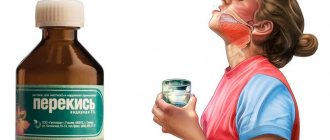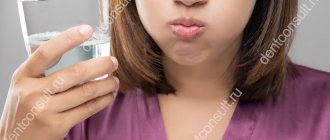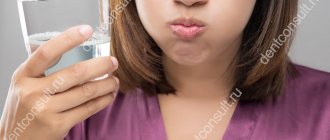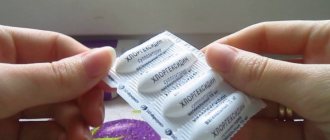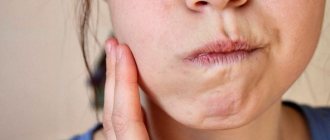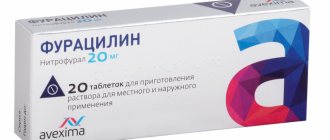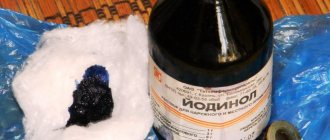In every home there is likely to be soda, salt or iodine, which have healing powers. Soda and salt are involved in cooking, used in economic activities and folk medicine. Iodine is not only an excellent antiseptic, but also an assistant in forensic cases, industry, and nuclear science.
Each product, in the form of solutions, is used individually for gargling and inhaling the throat, but mixed forms can also be used for more effective procedures at home. Let's first find out what functions each product performs, how it works and is used, and then move on to the healing trinity - “salt + soda + iodine”, the features of their use and the recommended proportions for gargling.
The healing properties of soda for throat diseases
Soda is an excellent disinfectant used for diseases of the oropharynx. During infectious and viral infections of the respiratory system, soda rinses alkalize the mucous membranes and inhibit the development of pathogenic microflora, which likes to multiply in an acidic environment.
Under the influence of soda, not only various cocci die, but also fungal infections are eliminated. In the ENT office you can often hear the expression: “You no longer have pus in your tonsils, these are mushrooms.” When the spread of bacteria is stopped, the patient’s immune system quickly “deals” with the remaining harmful agents.
Rinsing with a soda solution helps to dilute accumulated mucus, soften the tonsils and wash out old and fresh “plugs” from them, and reduce swelling of the pharynx. Under the influence of the solution, pain and sore throat are reduced, small wounds are regenerated (healed).
While gargling, patients notice that the condition of their gum mucosa has improved, because... the solution inevitably gets there, so it’s no secret that soda also occupies an important position in dentistry. Dentists often recommend soda rinses to their patients if there is an infectious process in the oral cavity.
Soda has gained great popularity in ENT pathologies, in particular tonsillitis, when the lacunae of the tonsils are filled with pyogenic contents, causing chronic processes in the body. Intensive rinsing helps dissolve these inclusions and remove them out.
Sometimes, after several procedures, the patient already sees “plugs” in the sink of a white, yellow or greenish hue (they feel rather dense to the touch). And when examining the throat, peculiar “holes” are discovered where purulent “plugs” were located.
An article on the topic - how to treat caseous plugs in the throat.
How to properly perform the rinsing procedure?
Before you begin such manipulation, make sure that you have no contraindications to this. Iodine cannot be used for too long, as it significantly dries out the mucous membrane. Also, adding iodine to a soda-salt solution should be avoided in the following cases:
- in case of chronic atrophic pharyngitis;
- when the temperature threshold increases;
- in case of development of liver pathologies;
- with tuberculosis;
- during gestation;
- with the development of hemorrhagic type diathesis.
In order for such a procedure to give a positive result and you can get rid of pain in the throat, it must be carried out correctly. When gargling, consider a number of aspects:
- the liquid used for rinsing must be warm, but in no case hot;
- there should be no crystalline sediment at the bottom of the container containing the solution;
- the cooled liquid needs to be slightly warmed up, since a cold solution can provoke the development of complications;
- At a time, no more than one sip of solution liquid should be taken into the oral cavity;
- so that the soda-salt solution gets into the throat well, the head should be tilted back slightly;
- be careful and careful: the liquid should not enter the esophagus;
- during manipulation, you need to try to pronounce the letter “Y” - this way the liquid can go down the throat and thoroughly rinse the pathogenic areas of the mucous membrane;
- one procedure should last about half a minute;
- after each manipulation, it is not allowed to eat food or drink water (including tea, juice, coffee, etc.) for 20-25 minutes;
- each time it is better to prepare a new soda-salt solution, since the remaining liquid will lose some of its beneficial and antibacterial properties;
- The manipulation is best done after eating.
If rinsing with a soda-saline solution with the addition of pharmaceutical iodine for 2-3 days does not give a positive result, you should consult an otolaryngologist. The treating specialist will be able to make a diagnosis and prescribe comprehensive treatment. Be healthy!
Soda rinses with herbal infusions, lemon and homemade apple cider vinegar
Traditional healers advise diluting soda in herbal infusions: eucalyptus, chamomile, St. John's wort, calendula, sage, plantain. First, prepare an infusion (pour 250 ml of boiling water over a dessert spoon of herbs), leave for 40 minutes, and filter. 100 ml of the prepared chilled infusion (up to 30 degrees) is poured into a separate glass and 1/2 teaspoon of soda is added to it. The rinsing mode is the same as with a pure soda solution without additives.
Sometimes add 1/2 teaspoon of acidic drinks to the “soda + herbs” solution: lemon juice or homemade apple cider vinegar. This solution helps cleanse the tonsils (tonsils) from plaque. It is used in acute and chronic periods of tonsillitis.
Soda
Sodium bicarbonate or baking soda has a unique antifungal effect. Procedures with soda will allow you to quickly and effectively clean the oral cavity, eliminate plaque on teeth and block the activity of bacteria. Baking soda gently disinfects the oral cavity and reduces swelling. In properly selected proportions, baking soda with iodine for rinsing teeth has a unique effect. You will need one tsp. soda and a glass of warm water. Stir the liquid to avoid sediment. By following simple proportions, you will get an effective antiseptic. The amount of baking soda can be increased to two teaspoons to relieve acute pain.
Soda inhalations for treating throat
These inhalations will help with tracheitis, laryngitis, bronchitis, pharyngitis, when it is necessary to remove accumulated mucus and phlegm. Soda inhalations are popular in pediatrics and can be easily performed at home. If you don’t have a nebulizer at home, use the proven old-fashioned method: take a tablespoon of soda per liter of hot water (40–50 degrees) and mix.
Inhalation is carried out over a saucepan (7–10 minutes), covering the head with a terry towel. You should breathe evenly, taking calm and deep breaths. The procedure is performed once a day.
Important! With caution, you should use soda for gargling as part of the trinity “salt, soda, iodine”, especially if the following symptoms were previously noticed when using a soda solution separately: dryness and irritation in the throat, nausea, gag reflex, increased blood pressure, severe thirst , change in body temperature (increase).
We recommend reading:
How to carry out inhalations for a green runny nose and sore throat.
Features of inhalations for children.
How to treat herpetic sore throat in children.
Preliminary preparation of the oral cavity and throat mucosa
For diseases of the nasopharynx and tonsils, doctors recommend drinking plenty of fluids. Therefore, before the rinsing procedure, you need to drink warm tea, fruit juice or any preferred drink.
No additional manipulations to prepare the oral cavity are necessary.
The solution should be prepared immediately before rinsing. You cannot store it or use leftovers from the last time. It is necessary to select a suitable single portion, which will be enough for one procedure.
If a liquid of an uncomfortable temperature was used for cooking, then the home remedy must be preheated or cooled. All manipulations in preparation for rinsing and performing the procedure itself in children should be supervised by adults.
Salt and its healing effect on a sore throat
For all infectious and inflammatory pathologies of the throat, good results are obtained by frequent rinsing with a salt solution, used to destroy pathogenic microorganisms, and sometimes, to enhance the antiseptic effect, add soda and iodine.
As monotherapy, table salt ( sodium chloride NaCl), iodized salt, which includes potassium iodide or iodate, and sea salt are used. Salt rinses have a detrimental effect on accumulated mucus and pus, dissolve them, and cleanse the mucous membranes of accumulated pathogenic secretions.
In addition to the cleansing and antiseptic effect, salt is able to regenerate the affected mucous membrane, relieve swelling and inflammation, and reduce areas of hypertrophied tissue. It is not for nothing that salt has long been used by military doctors to treat gangrene, when access to antibacterial agents was limited. During the difficult years of the war, salt proved its irrefutable antiseptic ability.
Proportions of iodine, salt and soda for gargling with sore throat
What precautions should you keep in mind?
It is necessary to understand that rinsing with soda and saline solutions has a beneficial effect on the health of teeth and gums. But still, you shouldn’t forget about the measure. Excessive use of the composition may lead to the development of stomatitis in the mouth. The mucous membrane is very delicate, so under regular exposure to substances it can begin to loosen. Pregnant women are recommended to rinse with chamomile decoction. Because soda can cause vomiting. After the tooth extraction procedure, it is not recommended to rinse the mouth with either salt or soda. And you can make baths with these components only the next day after pulling out. It is very important that during the procedure the blood clot that should form in the socket after tooth extraction is not washed away. If allergic reactions to the soda solution occur, the procedures should be stopped immediately. It is also necessary to take into account that the use of solutions alone for the treatment of dental diseases is not enough. Comprehensive therapy and treatment under the supervision of a professional dentist is required.
Recipe for making a saline gargle
The salt solution is prepared in the same proportions as soda: for 100 ml of boiled water, slightly warm, take 1/2 teaspoon of salt.
The frequency of rinsing depends on the condition of the patient's throat. For pharyngitis, it is advisable to use 3-4 rinses per day; in case of sore throat, the frequency of procedures increases to 6-8 times a day. In parallel with rinsing, it is recommended to carry out saline rinsing of the nasal passages, because mucus most often flows down the throat from the nose and the infection circulates through the nasopharynx. Washing is carried out using a regular pipette or a disposable 2 ml syringe.
Benefits of Sodium Chloride
Salt is a natural antiseptic substance that promotes rapid healing of cracks and is marketed in the mouth. Salt can prevent the development of pathogenic microflora. Salt works great for severe tooth pain. The saline solution instantly penetrates through the cracks, washing away plaque and food debris. It is quite easy to prepare the product. You just need to take a glass of boiled water and add one teaspoon of table salt. The substance is one of the most used methods.
Soda-salt solution - a reliable and safe assistant
To prepare the required solution, take 1/4 teaspoon (2 grams) of soda and salt and dissolve them in 100 ml of boiled water. The water should be slightly warmer than room temperature, approximately 30 degrees. When gargling with natural antiseptics (soda and salt), it is important to maintain the correct proportions of all components; in some cases, it is recommended to add iodine.
Such gargles will be useful not only for the throat, but will also have a pronounced anti-inflammatory effect in case of dental diseases: periodontitis, stomatitis, glossitis, gingivitis, and will also help whiten tooth enamel.
Harm of the procedure
Despite the undeniable benefits of rinsing with a solution of soda, salt with added iodine, there is an opinion that they are harmful.
The main argument that persuades users to abandon traditional treatment is its unproven effectiveness. An alkaline solution with salt cannot be more effective than traditional medicines.
Also, opponents of traditional treatment describe the harm of each component for the human body:
- Soda (sodium bicarbonate) alkalizes and loosens the mucous membrane of the larynx, making it even more vulnerable to harmful microorganisms. The only exception is fungal infections. In addition, getting soda into the digestive tract can negatively affect the functioning of the stomach.
- Salt, washing away purulent plaque from the mucous membrane of the pharyngeal ring, can corrode damaged tissue. This aggravates the course of the disease, causing dryness and soreness.
- Iodine is not at all recommended for internal use. Even when gargling, the molecules are absorbed through the mucous membrane. For some thyroid diseases, this method can worsen health.
Opponents of soda gargling recommend using herbal decoctions and drinking berry fruit drinks with a high content of vitamin C for auxiliary treatment of the throat.
Iodine in therapeutic rinses and inhalations
Typically, iodine is part of a complex solution in combination with salt and soda, and is used for daily gargling when the mucous membrane is inflamed and swollen. The best effect from the use of iodine occurs in the case of purulent processes, when the tonsils contain necrotic tissue that spreads bacteria.
Iodine perfectly neutralizes pyogenic microbes, cleanses the mucous membrane and sanitizes the throat.
Add 3 drops of iodine to the prepared solution of salt and soda, volume 100 ml. Rinse three times a day. As acute phenomena subside, the frequency of procedures is reduced. If sea salt is used, there is no need to add iodine.
Iodine nets and iodine-based inhalations will help supplement rinsing and speed up the healing process.
Iodine mesh – absorbable therapy for the throat
Iodine meshes are used as absorbable therapy. Using a regular ear stick we draw horizontal and vertical stripes. This old method has long been used to prevent the development of abscesses after intramuscular injection of oil and other solutions.
In ENT practice, an iodine mesh is applied to the neck and sternum (do not touch the thyroid area). Thanks to this “coloring”, lymphoid granules in the throat during pharyngitis dissolve, microcirculation of blood vessels improves, swelling and inflammation are relieved.
Iodine inhalations
To carry out inhalations, you will need a liter saucepan with cooled boiled water, the temperature of which should not exceed 45 degrees. Drop 2-3 drops of iodine into this water and mix. Inhalations containing iodine last up to 5 minutes.
It should be noted that iodine treatment is not suitable for everyone, and it has its own contraindications: individual intolerance, hypertension, chronic atrophic pharyngitis, enlarged thyroid gland, pregnancy, and others.
Prepare the solution correctly: salt, soda, iodine
If you want to quickly get rid of painful sensations in the throat, then when the primary signs appear, you should start gargling. It is important to maintain the proportions of iodine, since its excessive addition can cause a burn to the mucous surface. Almost all people prepare such a solution according to the classic recipe.
Compound:
- purified water – 250 ml;
- table or unflavored sea salt - 1 tsp;
- pharmaceutical iodine – 3 drops;
- sodium carbonate – 1 tsp.
Preparation and use:
- The water should be boiled and cooled slightly.
- All of the above components must be added to the prepared purified water.
- Use a spoon to stir the solution until all the salt crystals dissolve.
- You should rinse your throat three times a day. It is best to prepare a new solution every day.
Proportion of iodine for health
Gargling with baking soda in proportion with iodine can affect thyroid function, so it is important to choose the correct proportion of the trace element.
Iodine entering the body is involved in the conversion of thyroid-stimulating hormone (TSH) into triiodothyronine (T3) and thyroxine (T4). These thyroid hormones affect metabolism, immune response, and other body functions.
Deficiency or excess of iodine causes, respectively, under or over activity of the thyroid gland, the cause of hypothyroidism and hyperthyroidism.
Low iodine intake (less than 100 mcg per day) increases TSH synthesis. The thyroid gland extracts the missing iodine from the blood to compensate for the lack of iodine intake from food.
With a daily iodine intake of less than 10-20 mcg, hypothyroidism and goiter, characteristic swelling in the neck, as well as constant fatigue, hair loss, excess weight, and fear of cold can occur.
Iodine deficiency during pregnancy slows down the mental, physical and neurological development of the fetus. Reduces the mental development of the child, in the absence of treatment the cause of childhood mental retardation.
Daily iodine intake:
- up to 6 months – 110 mcg,
- 7-12 months – 130 mcg,
- 1-3 years – 90 mcg,
- 4-8 years – 90 mcg,
- 9-13 years – 120 mcg,
- 14-18 years old – 150 mcg,
- adults – 150 mcg,
- during pregnancy – 220 mcg,
- when breastfeeding – 290 mcg.
Excessive iodine intake can also cause goiter, dysfunction of the thyroid gland, and its malignant disease.
Improper intake of iodine supplements causes symptoms of poisoning:
- Burning in the throat, mouth, stomach.
- Fever.
- Abdominal pain, nausea, vomiting, loose stools.
- Slow heart rate.
Additional vitamin supplements with potassium iodide may affect the effect of medications for hyperthyroidism, some diuretics, anticoagulants (prevent blood clotting), and medications for arrhythmia.
In the body, up to 80% of iodine is concentrated in the thyroid gland. The rest is in the blood, muscles, ovaries, and other organs.
Iodine is contained in seaweed, iodized salt, sea fish, milk, bread, eggs, and cheeses.
Some compounds in food suppress the synthesis of thyroid hormone. They contain turnips, broccoli, cabbage, and other cruciferous vegetables. Heat treatment destroys these compounds.
Povidone-iodine (lat. Povidonum-iodum, English Povidone-iodine) contains iodine compounds - a topical antiseptic with a wide spectrum of action. Disinfectant, bactericidal, antiviral, antifungal effects. The concentration of active iodine is 0.1-1%.
A study of the effectiveness of gargling with Povidone-iodine solution in comparison with other means showed a high level of bactericidal activity, the ability to completely destroy strains within 30 seconds. The conclusion is made about the benefits of rinsing for the prevention of colds and flu.
Another study also confirmed the effectiveness of Povidone-iodine in the treatment and prevention of sore throat, gargle for 30 seconds. In case of lesions in the mouth, it is recommended to rinse for up to 2 minutes.
There is preliminary evidence for the potential use of povidone-iodine as a prophylactic measure to reduce SARS-CoV-2 viral load in the oropharynx.


